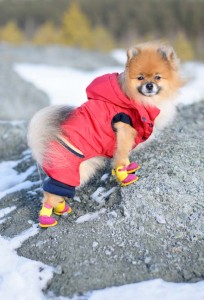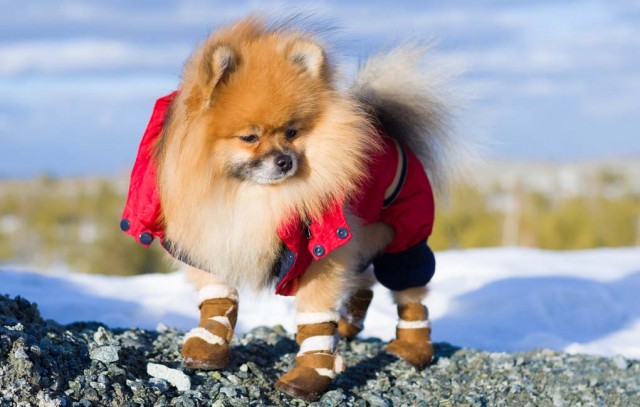
Table of Contents
We are rapidly approaching the middle of winter, and the weather channels are saying that this is possibly one of the coldest winters in a while.
It's December, and depending on which state you live in, it may be cold and snowy outside; it is a perfect time to consider the best dog booties for snow.
Not only that, but we're probably in for an even worse case of cold and snow in January. Brrr…
But no matter how cold it is outside, you still need to take your dogs for a walk. Now you’ve laced up your boots, secured your cap, and slipped on some toasty mittens.
All ready to take the dog and go outdoors. But what about your dog? Is he ready for the cold winter season with a pair of best dog booties for snow and ice?
Probably not. Veterinarians recommend pet owners invest in some dog winter clothes.
When it comes to getting our Fido, our dogs' only winter gear is usually dog leashes and dog harnesses, if that.
Why not give our beloved pets the same type of protection from cold, ice, and snow that we love giving ourselves?
Best dog booties for snow are often the first item dog owners need to look at if they wish to protect their canine's paws.
Our editor, Samantha, has previously written several times about the importance of preparing your dog for a cold-weather season.
Take a look at the below articles for reasons why it's vital to ensure your dog is warm this winter:
If you already have some dog boots, particularly waterproof dog boots, then you may have experienced how difficult it can sometimes be to put them on a dog.
For advice and a step-by-step video guide on how to do this, please see the below link.
RATED: The 50 Best Dog Shoes of All Time
Best Dog Booties for Snow to Keep Your Dog Safe This Winter
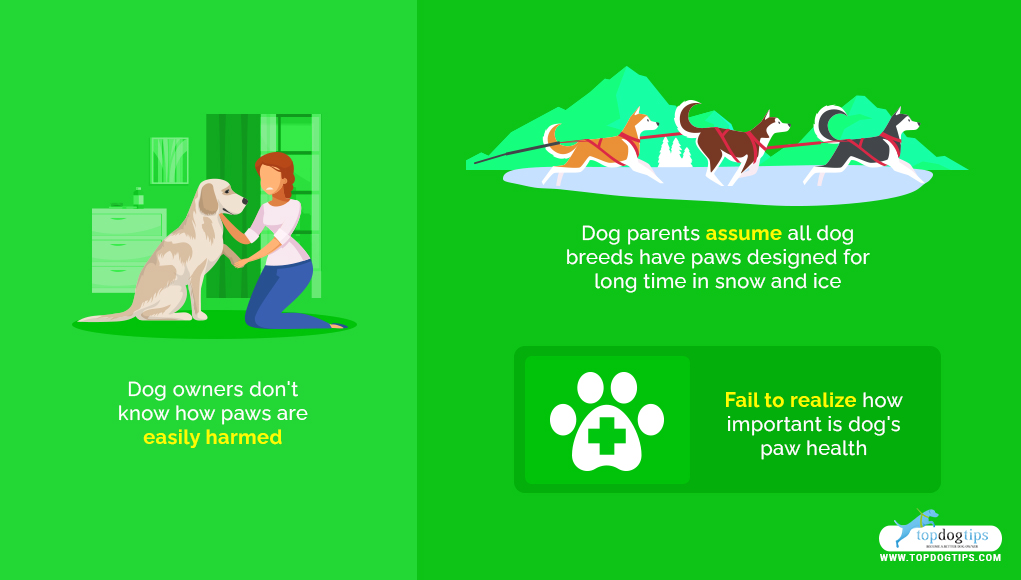
Why aren't the best dog booties for snow more popular?
Dog jackets, coats, and booties are all available and good options that can provide your dog with a barrier to cold weather conditions.
Making the decision this winter whether to include or not include things like best dog booties for snow and other winter season items as part of your dog’s wardrobe requires taking into account several factors.
RELATED: Does Your Puppy Need Dog Boots?
Not all dog owners are convinced that putting doggy boots on their canines is necessary. However, what they fail to realize is how important a dog's paw health is.
Dog booties for snow aren't that popular among pet owners yet because not many dog parents know that dogs can actually harm their paws very easily.
Most parents assume that all dog breeds have been designed to spend a long time on the snow and ice in winter, but that is not the case, according to veterinarians and dog experts.
Below, I will discuss some of the reasons dog footwear might be a good idea for your pet.
I'll point you to some reputable sources that list the reasons as to why, take a look at a few of the best dog booties for snow and other dog winter supplies, and provide general tips for winter weather dog care.
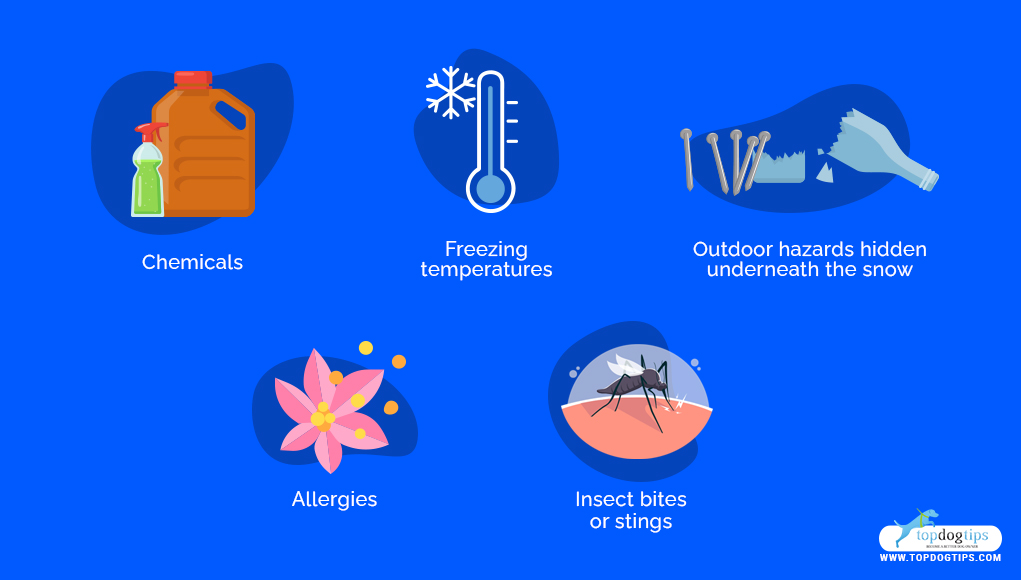
Your dog's paws need protection in winter.
Let’s take a moment to appreciate how important dog paw health is to our canines.
American Kennel Club has written many articles on how paws act as a structural base, support the rest of a dog’s body, absorb impact, and perform locomotory functions.
Certain canine breeds have specific adaptations to their paws that help them perform tasks like swimming or treading ice better than others.
They use their paws to defend themselves, chase down prey, and escape from danger.
An article from the American Kennel Club’s Canine Health Foundation website illustrates how critical paws are to a dog’s survival.
The site quotes Chris C. Cowing, D.V.M., president of the California Veterinary Medical Association in Sacramento, CA. Stating:
“Wintertime presents more issues for dogs with salt on the roads, icy streets and frostbitten toes. To prevent cold weather damage to dog's paws, avoid going outside for long periods of time.”
“If damage occurs to one paw, a dog can still get around, but it will limp. Damage more than one paw and the animal is severely handicapped.”
Even though dogs come equipped with their own fur coats and sturdy footpads, it is untrue that they don’t require protection from the elements.
Yes, dogs are descendants of other canines, like wolves, who can survive in the wild.
However, dogs have been domesticated by human beings longer than any other animal on Earth.
As a result, they’ve evolved to have dramatically different qualities and needs.
A dog who has spent his life indoors, on cool linoleum floors, may burn its paws on hot summer asphalt and get paw frostbite if he spends time on the cold surface without any winter dog booties for snow.
Temperature and chemicals can harm your dog's paws
Pet parents who live in a place where winter weather means snow and ice, a dog’s paws face many challenges, the least of which is freezing temperatures.
But that is not the only reason to look for some of the best dog booties for snow, ice, and other weather-related occasions.
An often overlooked but serious threat to your dog’s feet is chemicals.
Many of the substances used in common icemelt products, whether applied by your city or your neighbor, can cause illness or dryness and crack for your dog's paws.
Additionally, once your dog comes in from the cold without wearing any dog boots, they can track these chemicals into your home, which presents hazards to babies and small children, who often spend a lot of time on the floor.
Other outdoor hazards for dogs include cuts and abrasions.
Your pup may encounter broken glass, rusty nails, and other jagged surfaces that can puncture toe pads.
All these dangerous things can be “conveniently” hidden underneath the snow, which is why the special best dog booties for snow alone exist today.
Moreover, whenever your dog is dashing through the snow or stepping in slushy puddles, very often, the hair between toe pads becomes frozen and collects layers of ice in your pooch's paws.
These ice layers, aside from being uncomfortable, slick, and cold, can slice or stab your dog’s feet, causing pain and opening a pathway for infection.
Allergies and insect bites or stings can cause severe irritation and health concerns for dogs too.
While these dangers are significantly reduced during winter months, especially in areas of the world that experience frost and ice, they’re not absent.
Many plants release pods and seeds when it gets cold outside, which can cause problems as much as leaves and pollens can.
When dealing with extreme weather, such as very hot or very cold temperatures, blizzards, heavy rain, and similar, it’s good practice to take a look at your dog’s paws when you come in from your daily exercise to make sure there are no thorns or burrs stuck in between their toes.
If you notice issues with your dog's paws very often, consider investing either in some of the best dog booties for snow or just a general pair of dog boots.
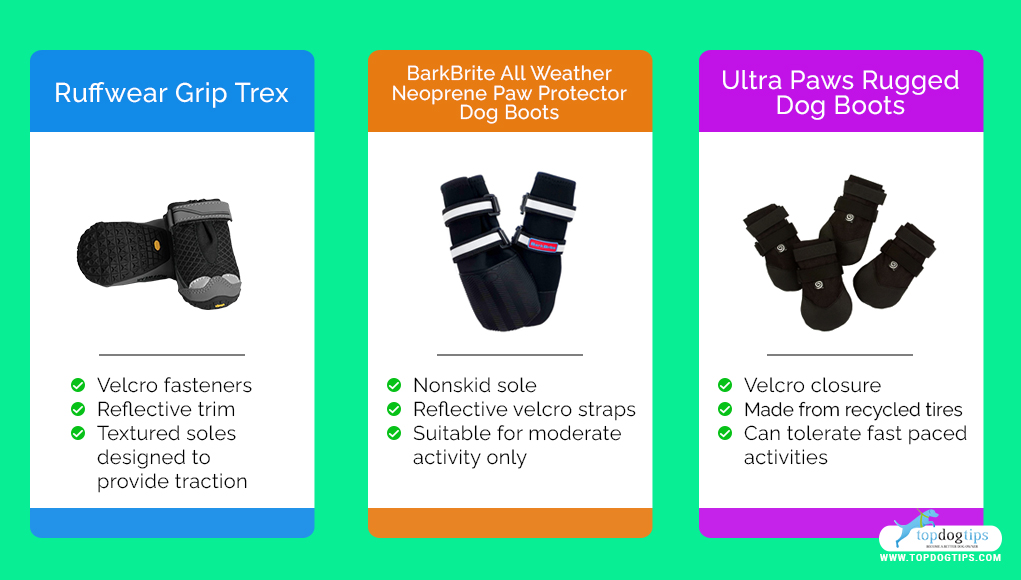
Best dog booties for snow that are currently trending
Now that you’ve learned about some of the risks of taking your dog out barefoot in the cold (or hot) weather, let’s take a look at some of the most often recommended solutions, particularly the best dog booties for snow, ice, and the winter season in general.
Fortunately, there is an abundance of footwear for dogs on the market available today.
Doggy boots vary by degree between function and fashion, and it can be difficult to sort through all of the options. We compiled the shortlist below with an eye on dog winter weather protection specifically.
Special consideration was also given to winter dog products that get consistently high ratings from dog owners.
Ruffwear Grip Trex
 Ruffwear Grip Trex is a popular choice, endorsed by dog parents in pet owner forums all over the web. These doggy boots feature velcro fasteners, reflective trim, and textured soles designed to provide traction. Two color choices are available: grey and red.
Ruffwear Grip Trex is a popular choice, endorsed by dog parents in pet owner forums all over the web. These doggy boots feature velcro fasteners, reflective trim, and textured soles designed to provide traction. Two color choices are available: grey and red.
We all know the manufacturer well, Ruffwear, who consistently puts out quality products.
They have thoughtfully included guides to measuring your dog's feet and choosing the right size of Ruffwear dog booties, as well as tips for introducing first-time wearers to dog footwear on their website.
Here's some great advice on wearing the best dog booties for snow:
BarkBrite All Weather Neoprene Paw Protector Dog Boots
 BarkBrite All Weather Neoprene Paw Protector Dog Boots also get great ratings on Amazon and a lot of positive reviews from dog owners. These come in five different sizes, so they may be a better option if you’re having difficulty finding the right fit with other brands of best dog booties for snow. They also feature a nonskid sole and reflective velcro straps.
BarkBrite All Weather Neoprene Paw Protector Dog Boots also get great ratings on Amazon and a lot of positive reviews from dog owners. These come in five different sizes, so they may be a better option if you’re having difficulty finding the right fit with other brands of best dog booties for snow. They also feature a nonskid sole and reflective velcro straps.
These dog boots come lined and are water-resistant as well.
BarkBrite does recommend their dog booties for “moderate” activity, so if you’re planning something rigorous, you may want to check the company’s return policy (or try Ruffwear's dog boots instead).
The best place to shop for these booties seems to be Amazon, as BarkBrite’s site is not robust.
Ultra Paws Rugged Dog Boots
 Ultra Paws Rugged Dog Boots are a favorite among dog owners for their staying-on power. These dog booties also utilize a velcro closure but are padded around the ankle to create a snug fit without being too abrasive. They come in four different sizes and three color choices. The soles of these dog boots are made from recycled tires, so they’re environmentally friendly as well as dog-friendly.
Ultra Paws Rugged Dog Boots are a favorite among dog owners for their staying-on power. These dog booties also utilize a velcro closure but are padded around the ankle to create a snug fit without being too abrasive. They come in four different sizes and three color choices. The soles of these dog boots are made from recycled tires, so they’re environmentally friendly as well as dog-friendly.
For dogs who tend to drag their feet, the soles of Ultra Paws dog boots wrap up over the toe area, protecting the front and top of the foot and the bottom.
Most reviewers rated these doggy boots highly because they remained securely on their dog’s feet, even while engaging in fast-paced activities like Frisbee chasing, hiking, and tearing around the yard.
Those are my personal top picks for the best dog booties for snow; however, there are other dog winter boots available online or in pet stores that you may want to take a look at before making the purchase.
A few quick winter dog care tips
In addition to the products above, here are some general dog care tips that will help your canine brave the elements successfully.
Of course, you’ll need to consult your vet before changing or supplementing your pet’s diet.
- In winter, you may want to increase your dog’s intake of Omega-3 fatty acids. These healthy oils from dog supplements contribute to your dog's skin and coat health, boosting your dog’s natural defenses.
- Even though it’s cold out, your dog still needs to have fresh water available. If you go out for long periods, be sure to carry some with you, and don’t let your dog drink from puddles. Toxic chemicals from parking lots and roads are washed away and collected in these small pools, presenting a danger to your dog.
- While you’re out and about, please pay attention to what your dog is doing with its feet. Check out any limping or dragging right away.
- It’s not a good idea to keep any dog tied up in the yard for long periods, especially without supervision, and certainly not in the cold.
Lots of dogs love to play in the snow and love the cool weather. With some quick research, dog winter boots, and careful preparation, your dog can enjoy the holiday season safely.
Interesting Reads:
- 17 Reasons Why Keeping Dogs Outside in Winter Is a Bad Idea
- DIY Insulated Winter Dog House: Keep Your Dog Warm in Winter
- 7 Vet Recommended Supplements for Dogs
- 6 Vet’s Tips on How to Care for Senior Dogs
- Improving Quality of Life for Senior Dogs
Disclosure: We may earn affiliate commissions at no cost to you from the links on this page. This did not affect our assessment of products. Read more here and find full disclosure here.



